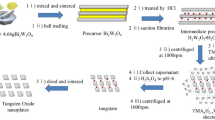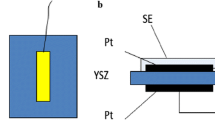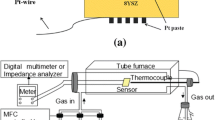Abstract
Layered-structure Bi2W2O9 powders synthesized by conventional solid-state reaction and treated by ball milling have been used to create an electrode for a mixed-potential-type NO2 sensor with yttria-stabilized zirconia as an oxygen ion conductor. This sensor was found to provide good sensitivity to NO2 at 500 °C, thanks to the grain refinement induced by ball milling. The electromotive force generated was linear to the logarithm of NO2 concentration in the range of 30–500 ppm, with analysis of the impedance spectroscopy revealing a similar linear correlation between the conductance of the electrode and the logarithm of NO2 concentration. The influence of CO2 was also examined and found to have little effect on the sensitivity of the sensor.










Similar content being viewed by others
References
Lee DD, Lee DS (2001) Environmental gas sensors. IEEE Sens J 1(3):214–224
Azad AM, Akbar SA, Mhaisalkar SG, Birkefeld LD, Goto KS (1992) Solid-state gas sensors: a review. J Electrochem Soc 139:3690–3704
Wang K-L, Yan H-Q, Liu J, Wang E-F (2003) Nitrogen oxides chemical sensors. J Wuhan Univ (Nat Sci Ed) 49(4):428–432
Miura N, Kurosawa H, Hasei M, Lu G, Yamazoe N (1996) Stabilized zirconia-based sensor using oxide electrode for detection of NOx in high-temperature combustion-exhausts. Solid State Ionics 86–88:1069–1073
Elumalai P, Miura N (2005) Performances of planar NO2 sensor using stabilized zirconia and NiO sensing electrode at high temperature. Solid State Ionics 176(31–34):2517–2522
Akbar S, Dutta P, Lee CH (2006) High-temperature ceramic gas sensors: a review. Int J Appl Ceram Technol 3:302–311
Miura N, Lu G, Yamazoe N, Kurosawa H, Hasei M (1996) Mixed potential type NOx sensor based on stabilized zirconia and oxide electrode. J Electrochem Soc 143(2):L33–L35
Sowri Babu K, Ramachandra Reddy A, Sujatha C, Venugopal Reddy K, Mallika AN (2013) Synthesis and optical characterization of porous ZnO. J Adv Ceramics 2(3):260–265
Liu Y, Parisi J, Sun X, Lei Y (2014) Solid-state gas sensors for high temperature applications—a review. J Mater Chem A 2(26):9919–9943
Ying C, Huihu W, Qinbiao Z, Ping L, Shijie D (2013) Theoretical calculation and analysis of ZrO2 spherical nanometer powders. J Adv Ceramics 2(1):21–25
Shi W, Fen T, Jiang D, Li Q (2015) SO2 gas sensor based on Ag-Ag2SO4-BaSO4 sensing electrode. Ionics 21(6):1719–1723
Miura N, Zhuiykov S, Ono T, Hasei M, Yamazoe N (2002) Mixed potential type sensor using stabilized zirconia and ZnFe2O4 sensing electrode for NOX detection at high temperature. Sens Actuators B 83:222–229
Miura N, Lu G, Yamazoe N (1998) High-temperature potentiometric/amperometric NOx sensors combining stabilized zirconia with mixed-metal oxide electrode. Sens Actuators B 52:169–178
Macama ER, Blackburn BM, Wachsman ED (2011) The effect of La2CuO4 sensing electrode thickness on a potentiometric NOx sensor response. Sens Actuators B 157:353–360
Sun X, Zhang C, Fen T, Jiang D (2015) Sensing behavior of mixed potential NO2 sensors equipped with LaMO3 (M = Fe or Cr) sensing electrodes. Ionics 21(6):1725–1730
Di Bartolomeo E, Kaabbuathong N, Grilli ML, Traversa E (2004) Planar electrochemical sensors based on tape-cast YSZ layers and oxide electrodes. Solid State Ionics 171:173–181
Tu Y, Li Q, Jiang D, Wang Q, Fen T (2015) Microwave intercalation synthesis of WO3 nanoplates and their NO-sensing properties. J Mater Eng Perform 24(1):274–279
Grilli ML, Chevallier L, Vona MLD, Licoccia S, Di Bartolomeo E (2005) Planar electrochemical sensors based on YSZ with WO3 electrode prepared by different chemical routes. Sens Actuators B Chem 111–112:91–95
Yang J-C, Dutta PK (2009) Solution-based synthesis of efficient WO3 sensing electrodes for high temperature potentiometric NOx sensors. Sens Actuators B 136(2):523–529
Kudo M, Ohkawa H, Sugimoto W, Kumada N, Liu Z, Terasaki O, Sugahara Y (2003) A layered tungstic acid H2W2O7ÆnH2O with a double-octahedral sheet structure: conversion process from an aurivillius phase Bi2W2O9 and structural characterization. Inorg Chem 42(14):4479–4484
Miura N, Nakatou M, Zhuiykov S (2004) Development of NOx sensing devices based on YSZ and oxide electrode aiming for monitoring car exhausts. J Ceram Int 30:1135–1139
Zhuiykov S, Ono T, Yamazoe N et al (2002) High-temperature NOx sensors using zirconia and zinc-family oxide sensing electrode. Solid State Ionics 152:801–807
Zhuiykov S, Muta M, Ono T et al (2001) Stabilized-zirconia-based NOx sensor using ZnFe2O4 sensing electrode. Electrochem Solid-State Lett 4:H19–H21
Xia H, Wang Y, Kong F et al (2008) Au-doped WO3-based sensor for NO2 detection at low operating temperature. Sens Actuators B Chem 134(1):133–139
Jian J-W, Yang B-C, Zhang Y-C (2004) The application of AC impedance technology on oxygen sensor of solid electrolyte. J Funct Mater 4(35):464–466
Author information
Authors and Affiliations
Corresponding author
Rights and permissions
About this article
Cite this article
Wu, L., Xia, J., Wu, J. et al. A mixed-potential-type NO2 sensor based on a layered-structure Bi2W2O9 sensing electrode. Ionics 21, 3239–3244 (2015). https://doi.org/10.1007/s11581-015-1510-3
Received:
Revised:
Accepted:
Published:
Issue Date:
DOI: https://doi.org/10.1007/s11581-015-1510-3




